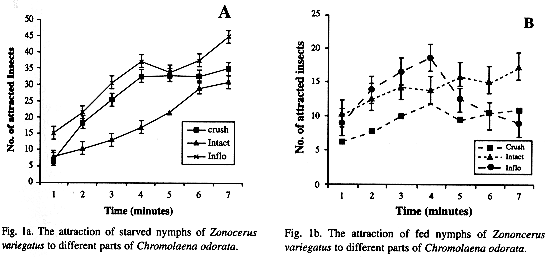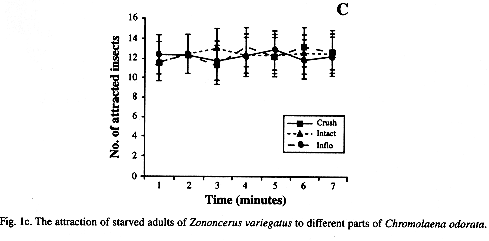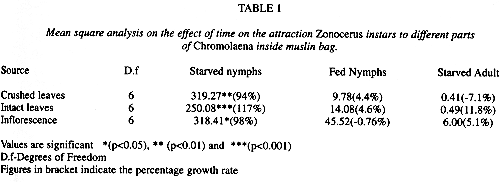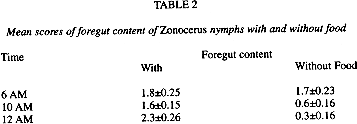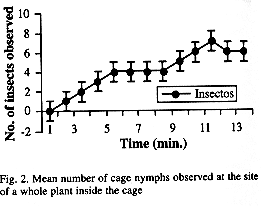Services on Demand
Journal
Article
Indicators
-
 Cited by SciELO
Cited by SciELO -
 Access statistics
Access statistics
Related links
-
 Similars in
SciELO
Similars in
SciELO  uBio
uBio
Share
Revista de Biología Tropical
On-line version ISSN 0034-7744Print version ISSN 0034-7744
Rev. biol. trop vol.49 n.2 San José Jun. 2001
A. Babatunde Idowu 1 Alfred Akinsete 2
Received 9-XI-2000. Corrected 24-VIII-2000. Accepted 27-X-2000
Abstract
Zonocerus variegatus is a common grasshopper in parts of west and equtorial Africa.The distribution in Nigeria extends from the lowland rainforest zone to the savannah in the north. The influence of lure on the behaviour of grasshopper inside cages (120 insect per cage) was investigated. Nymphs and adults of Zonocerus variegatus responded positively to intact leaves,crushed leaves and inflorescence of the common compositae weed Chromolaena odorata inside muslin bags, and intact plants. There were significant differences in the attraction recorded for starved nymphs, fed nymphs and starved adults. Attraction was more to intact leaves and is by olfaction. The increase in the attraction of starved nymphs is time dependent. Attraction to plant parts ceased after the plants were dried for 24 and 48 hours at room temperature and when plants were placed in transparent polythene bags. Gut motility and gut activity were higher during the day than at night. Nymphs, adults and egg pods placed separately inside muslin bags were not attractive to adults or nymphs.
Key words
Z. variegatus, attraction, nymphs, adult, instars, Chromoleana odorata, behaviour.
Laboratory and field studies have provided evidence that plant volatiles could cause attraction and host plant recognition by insects either in situ or in vivo as extracts (Landotl 1993, Hossaert et al. 1994). Attraction to the food plants is mostly by olfaction for long and short distances (Landolt 1993, Hossaert et al. 1994). Evidences also abound that pheromones are important both in long-range and close-range mate choice; parapheromones may be very useful in pest management because of their influence on male mating success (Boake et al. 1996).
Zonocerus variegatus, like some other members of the family Pyrgomorphidae, is aposematically coloured, sequesters toxic chemicals from plants, and commonly lives in dense groups (Chapman et al. 1986). The insect feeds on a wide range of crops from plantation crops such as coffee and banana as well as a wide variety of subsistence crops, notably cassava and some weed plants (Chapman et al. 1986). Z variegatus begins feeding in the morning when the temperature reaches about 26oC (Okere 1980) or 23oCwith a slowing down at temperature over 35oC (Kaufmann 1965). Modder (1983) found out that confined nymphs of Z. variegatus have the ability to start active feeding in the morning at a temperature as low as 17oC and at the extreme massive feeding was recorded at 34oC. Later in the day (mostly in the evening), they have the ability of ascending to the tops of their food plants to roost.
The result of the relationship between the Compositae weed, Chromolaena odorata and Z. variegatus supports that olfaction functions over short distances (Modder 1984). On the other hand, Kaufmann (1965) observed that Z. variegatus were attracted to vertically placed objects without discrimination between palatable and unpalatable plants provided they were within 7cm from where the objects were placed. She also observed that Z. variegatus is positively phototrophic and follows the movement of the sun in the cage. The present studies are aimed at determining the attraction of Z. variegatus to different parts of Chromolaena odorata (a plant that is fed upon by nymphs and serves as oviposition plants for adult Z. variegatus (Chapman et al. 1986). The effect of certain factors on the attraction of the insects to plants will also be looked into.
Materials and Methods
Nymphs and adult instars of Zonocerus variegatus were collected from different sites inside the campus of University of Ibadan, Ibadan. The insects were kept in wire mesh cages (30 x 30 x 45cm) and fed daily on fresh leaves of Acalypha wilkesiana and Manihot esculenta. The insects were maintained at the natural photoperoids under room temperature of 29+ 2oC and normal relative humidity (79 – 85%). Egg pods of Z.variegatus were collected from the oviposition site at Ayepe in Oyo State and kept inside a polythene bag. Prior to the start of the experiment, the insects were starved for a minimum of twelve hours. Plants used for the experiments were collected 5-10 min before the from the field and kept inside a polythene bag before use. The egg pods were separated from adhering soil particles before use.
In the 1st set of experiments, the plant parts were placed in a muslin bag (7cm x 4cm) tied to the mouth with a thread and suspended along the outside of the cage farthest from the light. For the other experiment, the plants were placed inside a transparent polythene bag, tied also at the mouth and placed vertically inside a beaker, which was later placed inside the cage containing the insects. The egg pods, nymphs and adults were also placed separately inside muslin bags and suspended outside the cage. The experiment normally commenced at 10 a.m or 2 p.m, which coincide with the start of the feeding period of Z. variegatus (Modder 1983). Each experiment lasted for 30 min. The number of insects at the start of all the experiment was 120 and the number found at the site of the lure were counted and recorded at the interval of 5 min. The site in which the bag containing the lure was hanged represented the whole side of the cage.
In the 2nd set of experiments, Zonocerus attracted to the site of a lure were picked immediately as they arrived and kept inside a specimen bottle, containing 70% alcohol. At the end of the experiment equal number of non-attracted grasshoppers were picked and stored inside another bottle containing 70% alcohol. The insects were later dissected using a dissecting microscope and the content of the foregut noted. Foregut of insect was scored as either 4, 3, 2 or 1 depending on its degree of fullness. The state of the foregut fullness of Zonocerus instars in relation to period of the day was also carried out. Equal number of insects was collected from two cages, in one there was food and in the other were insects starved overnight. The insects were also dissected at the end of the experiment and the state/content of the foregut recorded. Other experiments included: (1) The response of Zonocerus to plants dried for 24 hr and 48 hr at room temperature and used as lure. (2) Intraspecific attraction in which either egg pods, nymphs or adults were placed inside muslin bag and used in attracting other insects.
Results
There was an immediate response of the starved nymphal instars of Zonocerus variegatus to the site of the lure containing different parts of Chromolaena odorata (Fig.1). A steady increase in the number of insects that visited the site of the different lures during the course of the experiment was observed. There were significant differences in the numbers and accumulation of starved nymphs observed at the site of the different lures (Table1). Ranking by the numbers of insect that visited the lure and level of significance is as follows: intact leaves> crushed leaves> inflorescence (Table 1). ANOVA analysis of the result also showed that time was found to be positively and significantly associated with the number of starved nymphs attracted to the site of the different lures (Table 1).
Both fed nymphs and starved adults of Z. variegatus responded to the presence of the lures placed at the side of their cages at 0 hr. (Fig.1). For the fed nymphal instars, there was a gradual increase in the number of insects at the site of the lures until the 15th minute when a drop was observed for the inflorescence and crushed leaves (Fig.1). The number of fed nymphs attracted to the crushed leaves later increased, while that of the inflorescence declined until the end of the experiment. There was no positive effect of time on the number of insects observed for fed nymphs and starved adults (Table1). There was no significant difference in the number of fed nymphs and starved adults that visited the site of the lures (Table 1). A comparison of the responses obtained from the three groups (starved nymphs, fed nymphs and starved adults) for each treatment showed significant differences (Table 2).
Nymphs and adults, Zonocerus were not attracted to the site of food plants like Aspilia africana, Acalypha wilkesiana, Manihot esculenta and C. odorata placed in transparent polythene bag. Attraction to these food plants ceased when they were dried for 24 hr. and 48 hr.
Eggpods, nymphs and adults placed separately in muslin bags did not cause the attraction of adults and nymphs. Initially, there was no response by the nymphs of Zonocerus to the uncovered whole plant placed inside a beaker in their cage. First visit was recorded from the 5th min and subsequently increased (Fig.2).
The contents of the foregut of non-attracted nymphs and adults were significantly higher than those of attracted nymphs and adults (P>0.005) Mean score was 1.6±0.19 and 1.5±0.28 for attracted nymphs and adults respectively while that of non-attracted nymphs and adults was 2.4±0.25 and 2.6±0.26. No significant difference existed between attracted nymphs and adults and also non–attracted nymphs and adults (t – test, P>/0.05). Scores of foregut of insects with and without food at 6 a.m were not significantly different (t – test, P>/0.05) (Table 2). There was however a significant difference in the foregut content of nymphs with and without food picked separately at 10 a.m and 12 noon (Table 2). A striking observation on Table 2 is that the scores of the foreguts of nymphs without food decreased with time.
Discussion
The present study indicates that both nymphs and adults of Zonocerus variegatus whether starved or fed were attracted to the different parts of the plant Chromolaena odorata placed inside a muslin bag (Fig. 1). The attraction is olfactory. Studies have also shown that insects like Rhipicephalus appendiculatus (Hassan et al. 1994) and Trichogramma chilonis (Boo and Yang 1998) were attractive to the odour of plants. Boo and Yang (1998) reported significant differences in the attraction of T. chilonis to the parts of the plants used as also observed in this study. Crushing of the leaves of C. Odorata did not have a significant effect on the attraction of the grasshopper just as it was observed for the attraction of Trichoplusia ni to cabbage leaves (Landolt 1993). Result of present studies showed that starvation had a positive impact on the attraction of Zonocerus nymphs to the different lures (Table 1 and 2). Torr et al. (1995) had earlier reported that starvation has an increasing effect on the attraction of tsetseflies to plant odours.
Although, the nature of the chemical causing attraction to C. odorata is not known (Modder 1984), the plant is known to produce pyrrolizidine alkaloids (PAS) (Smith et al. 1981). The ability of Zonocerus in sequestering PAS from their food plant has been reported (Bernays et al, 1977). Recent studies showed that the repellent secretion of Z. variegatus contains alkaloids biosynthesised in its repellent gland is similar to those found in the extracts of C. odorata (Idowu and Modder 1998). Based on these facts, it is possible to suggest that the main attractant of Z. variegatus to C. odorata is the alkaloid content which it later employs for its defense (Idowu 1997). The vertically placed plant in the cage supports the observation of Kaufman (1965) that grasshopper are attracted to vertically placed objects.
Our study also confirmed that gut motility and gut activity were higher during the day than the night (Modder 1983). It is doubtful if digestion occurs maximally at night as reported by Modder (1983) since no significant difference was observed in the score of the foregut content of nymphs with and without food overnight collected at 6 a.m (Table 2).
No pheromone attraction was observed in the present studies. Laboratory and fields studies had revealed lack of evidence for pheromone-mediated secondary attraction in the fir engraver, Scolytus ventralis (Macias-Samano et al. 1998). Similarly, no pheromone attraction was demonstrated in Cis glabratus, in which males and females were both equally attracted to the odour of their host plant (Jonsson et al. 1997).
The results of these studies are consistent with the alternative hypothesis that host selection and aggregation by Z. variegatus are mediated solely by primary attractants from the host plant as reported for S. ventralis (Macias-Samano et al. 1998). It is concluded that the volatiles of C. odorata are important in host plant recognition by Z. variegatus and could be exploited as a tool in the biological control of the grasshopper.
Resumen
Zococerus variegatus es un saltamontes común en partes de Africa ecuatorial y oeste. La distribución en Nigeria se extiende desde la zona baja del bosque lluvioso hasta la sabana en el norte. La influencia del cebo sobre el comportamiento del saltamontes dentro de las jaulas (120 insectos por jaula) fue investigada. Las ninfas y los adultos de Z. variegatus respondieron positivamente a hojas intactas, hojas aplastadas e inflorescencias de la hierba común compuesta Chromolaena odorata dentro de bolsas de muselina y a plantas intactas. Hubo diferencias significativas en la atracción registrada en ninfas mantenidas con hambre, ninfas alimentadas y adultos mantenidos con hambre. La atracción fue más hacia hojas intactas y fue por olfato. El aumento en la atracción de ninfas mantenidas con hambre fue tiempo-dependiente. La atracción a partes de plantas paró luego de que las plantas fueron secadas por 24 y 48 hr a temperatura ambiente y cuando las plantas fueron puestas en bolsas transparentes de polietileno. La motilidad y actividad del intestino fue más alta durante el día que la noche. La ninfas, adultos y masa de huevos puestos separadamente dentro de bolsas de muselina no fueron atractivos para adultos o ninfas.
References
Bernays E.A., R.F. Chapman, L.J. McVeigh L. J.& W.W. Page. 1975. Food plants in the survival and development of Zonocerus variegatus (L). Acrida. 4: 33 – 46 [ Links ]
Bernays, E.A., R.F.Chapman,E.M. Leather,A.R. McCaffery & W.W.D. Modder. 1977. There lationship of Zonocerus variegtus (L) (Acrodoidea: Pyrgomorphidae) with cassava (Manihot esculeuta) Bull. Entomol. Res. 67: 391 –404 [ Links ]
Boake C.R.B., T.E. Shelly & K.Y. Kaneshiro. 1996. Sexual selection in relation to pest-management strategies Ann. Rev. Entomol. 41: 211-229 [ Links ]
Boo, K.S`., & J.P. Yang. 1998. Olfactory response of Trichogramma chilonis to Capsicum annuum J. Asia Pacific Entomol. 1: 2, 123 -129. [ Links ]
Chapman R.F., W.W. Page & A. R. MacCaffery. 1986. Bionomics of the variegated grasshopper Zonocerus variegatus in west and central Africa. Ann. Rev. Entomol. 31: 479 – 505 [ Links ]
Hassan, S.M., O.O. Dipeolu & M.M. Malonza. 1994. Natural attraction of livestock ticks by the leaves of a shrub. Trop. Anim. Health Produc. 26: 87-91 [ Links ]
Hossaert M., M. Gibernau & J.E. Frey. 1994. Chemosensory attraction of figs wasps to substances produced by respective figs. Entomol. Exp. Appl. 70: 185-191 [ Links ]
Idowu A.B. 1997. The defensive mechanism of Zonocerus variegatus (L). J. Afr. Zool. 111: 199 -203 [ Links ]
Idowu A.B. & W.W.D. Modder. 1998. Preliminary analyses of the chemical constituents of the repellent secretion of Zonocerus variegatus (Orthoptera: Prygomorphidae). Insect Sci. Appl. 18: 107-113. [ Links ]
Idowu, A.B. & O.A. Idowu. 2000. The mode of action of the repellent gland of Zonocerus variegatus (Orthoptera: Prygomorphidae) Biosci. Res. Comm.: in press. [ Links ]
Jonsson M., G. Nordlander & M. Jonsell. 1997. Pheromones affecting flying beetles colonising the polypores Fomes fomentarius and Fomitopsis pinicola Entomol. Fennica. 8: 162-165. [ Links ]
Kaufmann T. 1965. Observation on aggregation, migration and feeding habits of Zonocerus variegatus in Ghana (Orthoptera; Acrididae) Ann. Entomol. Soc. Ann. 58: 426 – 36. [ Links ]
Landolt, P.J. 1993. Effects of host plant leaf damage on cabbage looper moth attraction and oviposition. Entomol. Exp. App. 67: 79 -85. [ Links ]
Loughrin J.H., D.A Potter & T.R Hamilton-Kemp.1998. Attraction of Japanese beetles (Coleoptera: Scarabaeidae) to host plant volatiles in field trapping experiments. Envir. Entomol. 27: 395-400. [ Links ]
Macias-Samano, J.E., J.H. Borden, R. Gries, H.D Jr.Pierce & G. Gries. 1998. Lack of evidence for pheromone-mediated secondary attraction in the fir engraver, Scolytus ventralis (Coleoptera: Scolytidae). J. Entomol. Soc. British Columbia 95: 117-125. [ Links ]
McCaffery A. R., A. G. Cook, W. W Page & T. J. Perfect. 1978. Utilization of food by Zonocerus variegatus (L) (Orthoptera: Acrididea).Bull. Entomol. Res. 68: 589 -606 [ Links ]
Modder, W.W.D. 1984. The attraction of Zonocerus variegatus (L) (Orthoptera: pyrgomorphidae) to the weed Chromoleana odorata and associated feeding behaviour. Bull. Entomol. Res. 74: 239 –247 [ Links ]
Modder W. W. D. 1983. Diurnal variation in feeding and gut activity in nymphs of the African pest, grasshopper Zonocerus variegatus. Insects. Sci. Appli. 5: 527 – 531 [ Links ]
Okere A. N. 1980. Studies on the biology of Zonocerus variegatus (L) (Orthoptera; Acridoidea) Ph. D Thesis, University of Ibadan, Nigeria [ Links ]
Smith L. W., C. C. J. Culvenor. 1981. Plant sources of hepalotic pyrrolizidine alkaloids. J. Natur. Prod. 44: 129 - 52 [ Links ]
Torr S.J., D.R. Hall, J.L Smith. 1995. Responses of tsetseflies (Diptera: Glossinidae) to natural and synthetic ox odours. Bull. Entomo.l Res. 85: 157-166. [ Links ]
1Department of Biological Sciences.
2 Department of Mathematical Science, University of Agriculture, Abeokuta, Nigeria. Fax: 234-39-242700 E-mail: idowuab@unaab.edu.ng













